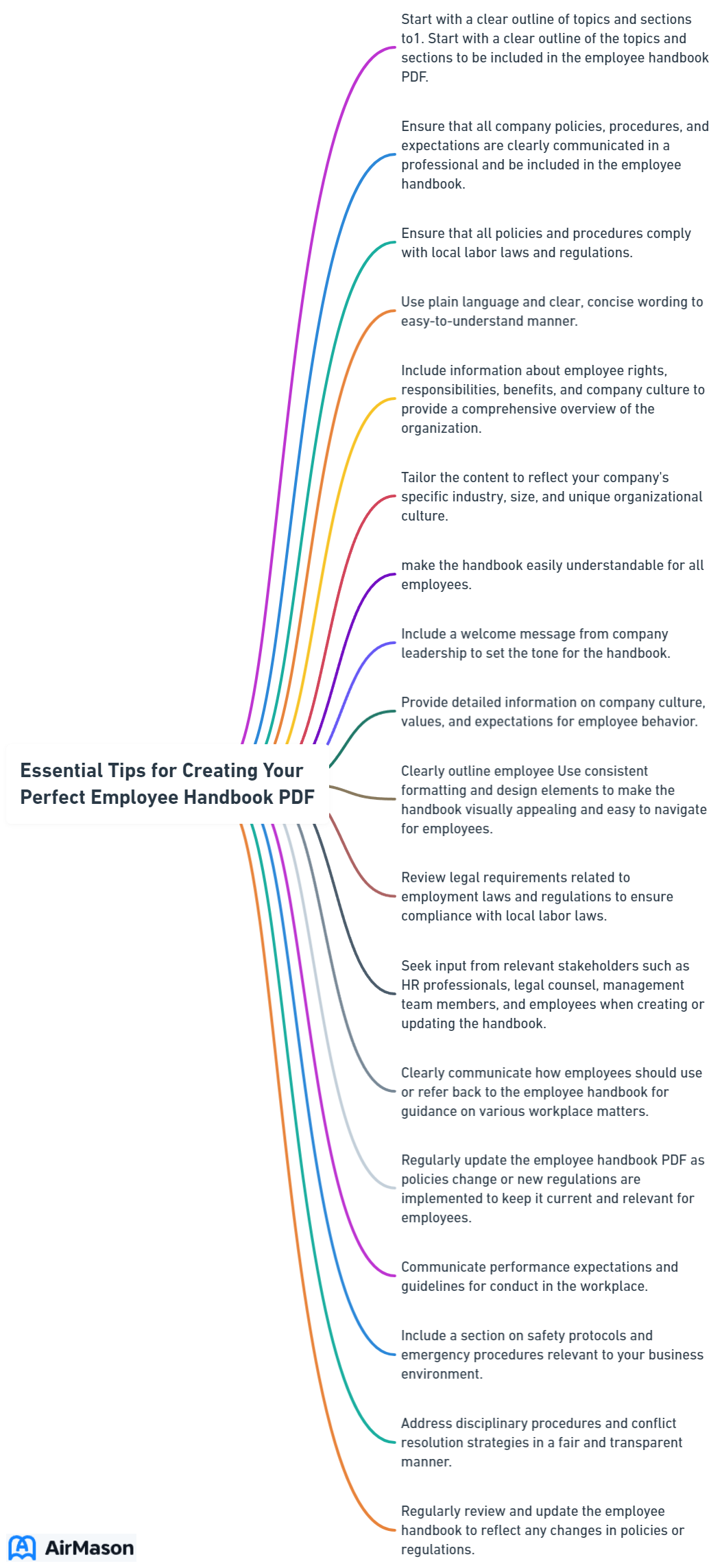
Creating a handbook PDF? This guide delivers straight-to-the-point advice on compiling a clear, legally compliant handbook. Expect practical tips on articulating company policies and culture, with a focus on PDF format benefits for trouble-free distribution and updating.
Key Takeaways
- An employee handbook should be comprehensive, clear, and updated, including mission, values, legal protections, and compliance along with company culture and emergency procedures.
- Using a PDF format for the handbook offers advantages such as universal compatibility, security features, ease of distribution, and simplified updates that help to reduce environmental impact.
- Regular employee feedback and scheduled reviews are essential for keeping the handbook relevant, accurate, and legally compliant, adapting to changes in laws, regulations, and company policies.
Employee Handbook Updates
Employee Handbook Updates are essential for keeping your company’s policies and procedures current and compliant with evolving laws and regulations. Regular revisions ensure that employees have access to the most up-to-date information regarding their rights, responsibilities, and benefits within the organization. These updates also provide an opportunity to reinforce company values and culture, aligning employee expectations with organizational goals. Additionally, revising the handbook allows for clarification of any ambiguities or inconsistencies that may have arisen since the last update, fostering a more transparent and equitable work environment. By regularly reviewing and updating your employee handbook, you demonstrate your commitment to staying abreast of changes in the legal landscape and to supporting your employees with clear and consistent guidelines.
Crafting Your Employee Handbook: A Comprehensive Outline
The employee handbook, sometimes referred to as an employee manual, is more than a simple document—it’s a compass that guides employees on their journey within your company. It communicates your company’s mission, policies, and expectations, serving as a reference point for new hires and a refresher for existing employees.
The backbone of the handbook is formed by:
- The company’s mission
- Values
- Vision
- Organizational chart
These elements underpin the understanding of the company’s objectives and each employee’s role within it. Clear and concise policies, or rules, are essential for effective communication within the handbook, allowing employees to grasp what is expected of them without getting lost in the legal jargon.
A table of contents could enhance the navigability of the office handbook for your employees. This can facilitate quick access to information, saving precious time that can be better spent on accomplishing tasks.
Key Sections to Include
Your handbook should include a Workplace Policies section that specifically addresses anti-harassment and health and safety. Adapting these policies to the specific legal requirements of your state and industry is fundamental, as it guarantees coverage of all protected categories like age, sex, race, and disability.
To enhance the handbook’s usability and comprehension, consider incorporating visual elements like team member photographs, software screen recordings, and infographics. These visuals can make the handbook more engaging and easier to understand, even for the most complex concepts.

Designing for Readability
An effectively designed employee handbook delivers information in an engaging and easily digestible way. Keep your language simple and engaging to ensure that even the most complex concepts are understood by all. To improve readability, use headings, sub-headings, bullet points, and paragraph breaks.
Additionally, incorporate visuals and use headers to make it easier for employees to navigate and prevent the intimidation of large blocks of text.
Legal Protections and Compliance
It’s vital for both your company and employees that your handbook adheres to legal requirements. Legal disclaimers like non-discrimination policies should be documented to inform employees of their rights and protections, confirming your company’s commitment to fairness and inclusion.
It’s imperative that your handbook aligns with updates to state-specific policies. Regular reviews and updates are necessary to keep pace with changes in labor laws and company policies, ensuring state law compliance. Covering areas like minimum wage and overtime regulations, anti-discrimination and harassment, and family and medical leave policies, are essential for the handbook’s legal compliance.
The Digital Advantage: PDF Format for Your Handbook

The selection of a PDF format for your employee handbook brings forth numerous benefits in our digital age. The PDF format is universally compatible across various operating systems and devices, ensuring a consistent presentation of the handbook’s content. Plus, PDFs can be password protected and encrypted, offering an extra layer of security for sensitive information.
Moreover, digitally sharing the handbook is easy and efficient. It can be quickly distributed to all employees, regardless of their location, via email or through the company intranet. This ensures that every employee has instant access to the most current version of the handbook.
Accessibility and Sharing
The PDF format excels in terms of accessibility and sharing. Not only can the handbook be easily shared with all employees via email or the company intranet, but it’s also compatible with mobile devices.
This makes it readily accessible anytime, anywhere, supporting remote or mobile employees. To ensure everyone is informed and has access to the handbook, clear communication and follow-up emails are recommended.
Update and Maintenance
The upkeep of a PDF employee handbook follows a simple process. When policies change, only the relevant pages or sections of the handbook need to be updated, unlike physical copies, where the entire book may need to be reprinted.
This not only saves time but also reduces the environmental footprint of your company.
Employee Handbook Pictures
Employee handbook pictures are an essential component of any well-designed employee manual. These images help to break up the text, making the handbook more visually appealing and easier to digest for employees. Including pictures also provides a visual representation of important information, such as company policies, procedures, and workplace expectations. Moreover, incorporating images can help to enhance employee engagement and retention by making the handbook more engaging and memorable. When selecting pictures for the employee handbook, it’s important to choose high-quality images that are relevant to the content and reflect the company’s culture and values. Overall, including pictures in the employee handbook can contribute to creating a more user-friendly and effective resource for employees.
Personalizing Your Handbook: Branding and Culture
Remember, as you craft your employee handbook, that it serves not just as a document but as a mirror reflecting your company’s culture and brand. Detailing your company culture in the handbook helps maintain a positive working environment and facilitates the onboarding process for new employees.
Using visual elements like graphs and images can make the handbook more engaging and solidify your company’s brand identity. Visual storytelling aids in communicating complex ideas in an evocative and memorable manner, adhering to your company’s brand guidelines.
Visual Elements
Visual elements are instrumental in enhancing the handbook. They not only make it more engaging but also effectively convey the company’s culture and brand identity. Tools such as Adobe Creative Cloud, Canva, and Piktochart enable the creation of professional visuals that align with your company’s branding.
Effective visuals exhibit consistency, simplicity, and strategic use of white space to emphasize important information. They aid in reinforcing the company’s messages and ensuring employees comprehend crucial policies and procedures. Additionally, simple and easy-to-understand visuals ensure comprehension across all employee backgrounds and skill levels.
Tone and Voice
Your handbook’s tone and voice should be a reflection of your company’s culture. Whether your company is professional, friendly, or somewhere in between, the voice in your handbook should reflect that. It should serve to empower your employees, guiding them to make informed decisions while upholding ethical standards.
Safety and Emergency Procedures

Safety holds paramount importance in the workplace. The safety section of your employee handbook should outline the company’s objectives for maintaining a safe workplace, organizing health and safety issues, and describing ongoing risk management.
Having an effective safety section in your handbook not only helps to provide protection against health risks but also fosters a positive working environment and decreases the likelihood of work-related accidents.
Workplace Safety Guidelines
Workplace safety guidelines in your handbook are paramount. They detail the prevention of injury and illness, as well as the responsibilities of the employees to adhere to these practices. Your handbook must specify procedures for timely reporting of accidents or potential safety hazards and the required adherence to established safety policies.
Furthermore, it’s crucial to minimize risks in the workplace, such as maintaining clear pathways to avoid falls and creating designated smoking areas to prevent fires.
Emergency Response Plans
Your employee handbook should include clear instructions for emergency operations, such as evacuation procedures in the event of a fire. It should also outline actions during severe weather events, including moving to safe areas during thunderstorm warnings or to designated tornado shelters during tornado warnings.
Benefits and Compensation Explained
The compensation and development section is one of the key aspects of the employee handbook. This section explains how employees are paid and how their professional development is supported.
Benefits and perks are outlined to ensure employees are fully aware of what the company offers, contributing to a well-informed workforce. Work hours, compensation, and benefits are clearly communicated to guarantee transparency and to safeguard against misinterpretations that could lead to legal complications.
Health and Wellness
Your employee handbook should detail the health and wellness benefits offered by the company. These benefits could include employer-sponsored benefits such as health insurance and retirement plans like a 401(k).
Wellness program policies should define available wellness resources and emphasize the voluntary nature of participation. Wellness resources provided by your company could include services like gym memberships, nap rooms, and access to wellness coaches.
Pay Scale and Increases
Your employee handbook should clearly outline the compensation structure for both exempt and non-exempt employees, indicating that non-exempt employees are eligible for overtime pay. The handbook should also detail payment intervals, informing employees whether they will receive weekly or bi-weekly paychecks.
Information on overtime pay should be provided, including the federal overtime rate of 1.5 times the hourly rate for hours worked beyond the standard 40 per week.
Code of Ethics and Conduct
Integrating a code of ethics and conduct into your employee handbook sets the behavior standard for your employees. Employees are held accountable for knowing and adhering to the values and standards set forth in the code of ethics and conduct. Failure to do so may result in disciplinary action.
The code of conduct provides guidelines on expected employee behavior such as professional presentation, substance use, and privacy of company data. Inclusion of Diversity, Equity, and Inclusion (DEI) initiatives within the code demonstrates the company’s dedication to fostering an inclusive workplace.
Ethical Practices
Your company’s ethical practices should be grounded in its mission, vision, and core values, providing a cultural framework for employee conduct. Ethical behavior expectations highlighted in the handbook include:
- Fostering teamwork
- Employee participation
- Respectful treatment of others
- Maintaining an inclusive work environment.
In addition, employees are expected to address and reflect upon decisions or behaviors that could stem from conscious or unconscious biases and to remain receptive to constructive criticism. Whistleblower protections ensure employees can report unethical practices without fear of retaliation.
Standards of Conduct
Your employee handbook should clearly outline the standards of conduct expected from your employees. To create an effective handbook, it’s helpful to refer to employee handbook examples. These standards should encompass:
- Non-discrimination policies
- Responsible internet and email use
- Avoiding conflicts of interest
- Following industry-specific legal requirements
Proper use of company resources and employment benefits should be clearly defined to prevent misuse and ensure they are utilized for business purposes and with care.
Developing and Evolving Your Handbook
To ensure your employee handbook remains a relevant and useful resource, it must be a dynamic document that evolves to reflect organizational changes and updates in employment law. Regular revisions ensure the handbook remains a relevant and useful resource for both current employees and new hires.
Regular Reviews and Updates
An annual review of your employee handbook should be conducted to:
- Keep pace with changes in federal, state, or local employment laws
- Update legal compliance
- Update company policy changes
- Provide opportunities to correct any errors or omissions
Regular handbook reviews are important to ensure that your handbook remains up-to-date and in compliance with current laws and regulations.
Scheduled updates for the handbook, such as on a quarterly basis, ensure ongoing relevance with industry standards and company changes.
Feedback Loop
A continuous feedback loop contributes to the success of your employee handbook. Fostering a culture that values feedback, especially from employees who contribute, encourages open communication and builds trust.
Gathering feedback can be effectively facilitated through the use of surveys, focus groups, and suggestion boxes, offering multiple channels for input.
How to Distribute Your Employee Handbook PDF
Following the crafting of your ideal employee handbook, the subsequent step is distribution. Employers should provide constant access to the employee handbook, making it available electronically on the company intranet and via email, and offering hard copies upon request.
Introducing the handbook in a scheduled meeting can be beneficial for clarifications, with HR support for coordinating access and addressing questions.
Digital Distribution Strategies
The use of an employee intranet for distributing the handbook can streamline HR processes, as it enables the sharing of the handbook and other vital documents in a single location. An employee intranet can facilitate knowledge sharing by allowing the handbook to be stored on the cloud and accessed from anywhere at any time.
When distributing the handbook via the company website, employers should publish the PDF through the website control panel and create a direct link to the handbook for employee access.
Hard Copy Considerations
For those employees who prefer a hard copy of the handbook, consider utilizing a loose-leaf binder format. This allows for individual pages for each policy and facilitates easy updating.
Employee Handbook Receipt Form
The employee handbook receipt form is a crucial document that acknowledges an employee’s receipt and understanding of the company’s policies and procedures outlined in the employee handbook. This form serves as proof that the employee has been provided with the necessary information and is aware of the expectations set forth by the organization. It typically includes details such as the employee’s name, signature, date of receipt, and acknowledgment of understanding. Employers use this form to ensure that all employees are informed about company policies and are held accountable for adhering to them. By signing the receipt form, employees affirm their commitment to following the guidelines outlined in the employee handbook.
Summary
In conclusion, crafting an effective employee handbook is an essential task, but it doesn’t have to be daunting. By incorporating clear guidelines, regular updates, and consistent branding, your handbook can serve as a comprehensive guide for your employees. Here’s to creating a well-informed, engaged, and productive workforce!
Frequently Asked Questions
When making a long trip you should stop for a rest?
When making a long trip, it’s important to stop for a rest every two hours or one hundred miles on interstate highways, as many highways have resting facilities.
Cars parked on the side of a highway at night should show?
Cars parked on the side of a highway at night should have their parking lights or hazard lights turned on to ensure visibility and safety for other drivers.
The most important thing in backing a motor vehicle is?
The most important thing in backing a motor vehicle is to look back carefully to ensure safety. It’s crucial to turn your body and head to the right to see through the back window and beyond the headrest when backing up.
Which of the following must you obey over the other three?
You must obey traffic officers over signs, signals, or pavement markings when it comes to regulating traffic. Their directions take precedence.
If you are being passed you should?
If you are being passed, do not increase your speed. Instead, move to the right side of your lane to give the other driver more room and a better view, and continue at your normal speed once the passing vehicle is ahead of you.
Important Disclaimer:
Please be aware that the content on this page has been generated by using artificial intelligence language models and may contain errors, inconsistencies, or outdated information. It is provided as-is without any warranties or guarantees of accuracy.
We strongly recommend using this content as a starting point for further research. We disclaim any liability for damages or losses resulting from the use or reliance on this content.